As networking bandwidth needs increase for users processing high resolution media files, especially past 10GbE, it is pushing more and more users from copper twisted pair (Cat6, etc.) toward fiber connections. Fiber optic cable offers a lot more possibilities, making it far more complicated than copper wiring. There is a whole new vocabulary of acronyms to keep all of the options straight, and various methods to multiply the data rates, which can be combined in numerous ways. This article is intended to orient the reader to many of the concepts and terms used in fiber networking, and lay the groundwork for understanding the various ways to move data around faster than 10Gb/s. While there is technically a standard for 25GbE over Cat8 copper cabling, if you have to replace your wiring for that speed, you might as well go to fiber. Plus twisted pair encoding adds latency and heat. So fiber is usually the best choice beyond 10GbE.
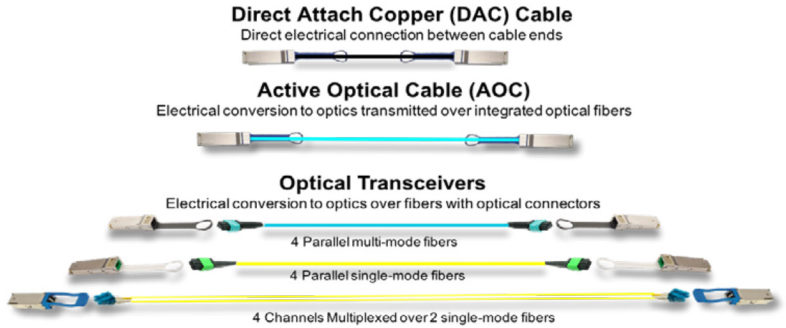 Fiber Cabling
Fiber Cabling
There are two main types of fiber cabling: single mode and multi-mode. Single mode is much thinner, but can transmit data over much longer distances. Multi-mode is thicker, and much more forgiving, allowing cheaper connections and electronics, at the cost of limited range. Multimode is like “fiber-lite” for shorter runs within buildings, instead of between cities. There are various grades of multimode fiber, rated for different transmission speeds, with the most relevant options being the older orange OM2 cables for 4Gb Fiber channel, which were replaced by the aqua colored OM3 cables for 8Gb Fiber and 10GbE connections. The violet OM4 cables support 25GbE for longer distances while the aqua cables are limited to 70M, while new lime green OM5 cables apparently support CWDM to quadruple the data rate to 100Gb. Single mode fiber is much simpler, without all the various levels and grades, but with much more expensive handling and connections, and is usually identified by a yellow jacket. Either variant comes in single or paired strands (for bi-directional communication) or in multi strand cables for running many channels in parallel.
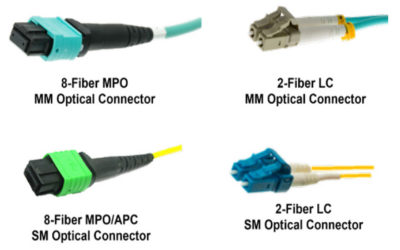 Fiber Connectors
Fiber Connectors
Either type of fiber cabling can utilize many different types of connectors on the end. Telecom uses ST and SC connectors for individual strands, LC is used for pairs, and MTP supports up to 12 strands, with variants that support 16 or 24 strands. Most users in the media and entertainment space will find themselves using LC connectors on their fiber, and may not even be aware that there are other options. MTP is used for 40GbE and 100GbE connections, which are more likely to be used in a server than a user workstation.
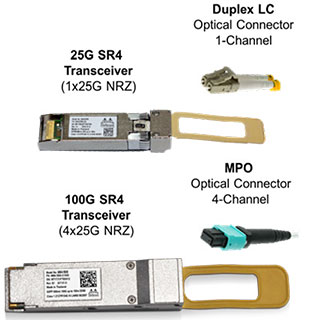 Fiber Transceivers
Fiber Transceivers
There are many types of fiber transceivers used for different ranges, and in different enclosures. SFP+ transceivers are the most common in workstations. Specifically interface cards and switches with the newer SFP28 connectors are used for 25GbE networking. The transceiver adapts this electrical connection to an LC fiber via a laser for outgoing data, and a light sensor for incoming data. Most users will see this connected to an aqua colored multi-mode cable, or a yellow single-mode fiber, which links them to a switch elsewhere in their building. There are also wider QSFP ports that interface quad channel data to fiber, usually using 8 of the 12 strands of an MTP fiber connector (using 4 in each direction). This approach is called Parallel Single Mode 4, or PSM4. There are also QSFP transceivers that can transmit all 4 channels over a single fiber pair (usually with a standard LC connector) by using four different frequencies (colors) at the same time, using a technique called Course Wavelength Division Multiplexing (CWDM). This allows 40GbE or 100GbE connections over a single fiber pair. (One fiber in each direction.) QSFP ports can also be adapted to use single channel SFP transceivers with a QSA adapter. And some SFP ports can be adapted to RJ-45 for twisted pair Cat6 connections, but there are some power limitations, because that interface is less energy efficient. Separately there are also other transceiver sizes like XFP and GBIC, but you are unlikely to see these in new network installations to end users.
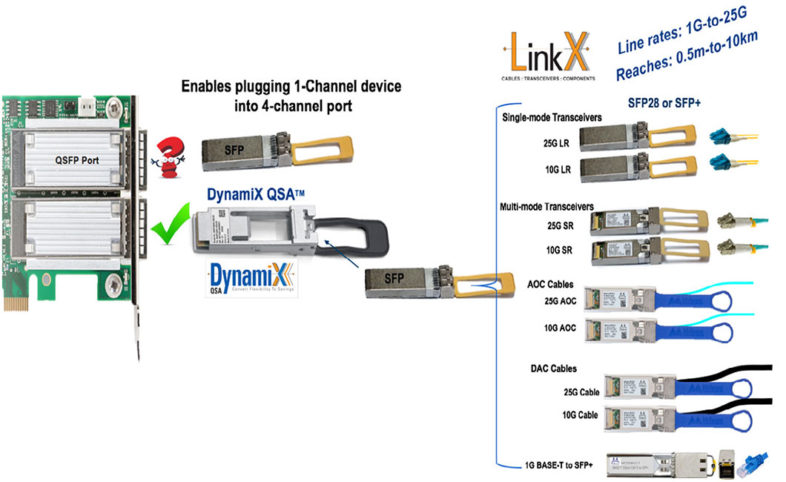 Active Optical Cables
Active Optical Cables
If this seems unnecessarily complicated, there are also active optical cables (AOC), that skip the LC or MTP connection to a transceiver, and just permanently connect the fiber to the ends that fit into SFP or QSFP ports. This simplifies the process of matching the correct components, especially for shorter runs, but the large SFP connectors on the ends may make it harder to run the wires through tight spaces and conduits. And the lengths are set when the cables are made in the factory, while LC connectors can be installed on site, with the right tools. but using prefabricated AOC lines can save on deployment costs, because AOCs can be mass produced and tested much less expensively that individual transceivers that have to be interoperable with other products. (The AOC is a closed system, engineered for a particular length, with known components.) It can also save on energy due to that engineering. There are also similar Direct Attached Copper (DAC) cables with SFP or QSFP ends, which are far simpler and cheaper, but are much thicker, and limited to very short runs, usually 1-3 meters. And while they are my preferred solution personally, this article is focused on Fiber based solutions.
PAM4 Encoding
Besides CWDM, there are two other methods that have been developed to increase the bandwidth of Fiber connections. The first is to vary the brightness of the light between 4 possible levels, allowing 2 bits of data to be transmitted with each clock cycle (00,01,10,or 11), which effectively doubles the data transmission rate. This is called PAM4 (Pulse Amplitude Modulation), compared to the normal NRZ (Non-Return to Zero) transmission method of the light being on or off. This approach requires newer SFP56 connectors on the electrical side, to get the data to the transceiver at that rate, before it encodes it onto the fiber. This offers 50GbE bandwidth over a single fiber pair, doubling the potential bandwidth of existing fiber cabling installations. One benefit of this approach is backwards compatibility, in that the SFP56 ports can still be used with SFP28 or older SFP+ transceivers, and same with the QSFP56 ports. And I believe that a PAM4 transceiver will fall back to NRZ transmission of the other side of the fiber isn’t compatible with the newer approach. PAM4 is not limited to networking, and is expected to be the method used to double the data-rate of PCIe in the next 6.0 standard, with similar backwards compatibility functions. There is also the PAM8 approach for encoding 3 bits of data in each clock cycle, but that is farther from commercial implementation.
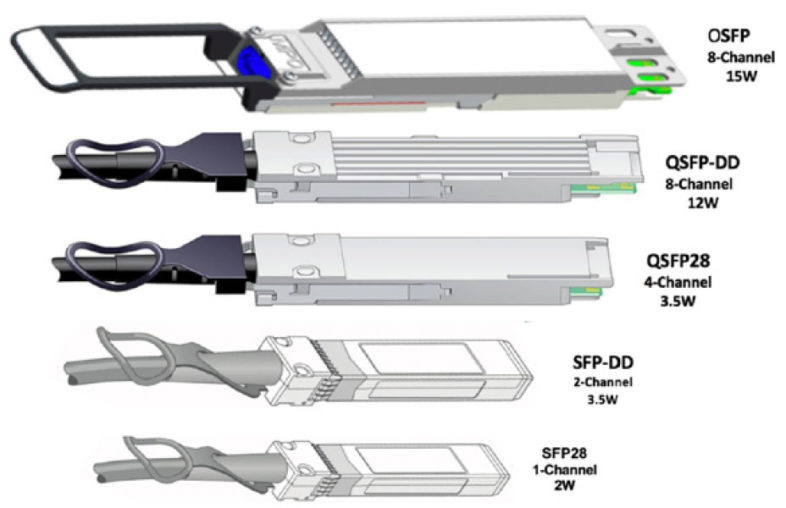 Double Density
Double Density
The second approach to doubling bandwidth in a given space is double-density. So an SFP-DD port has a second set of lanes, instead of running at a higher clock frequency. (Combining the two approaches offers a quadrupling in speed.) But this approach doesn’t save on fiber cable, it just offers twice the number of connections (and twice the total bandwidth) for a given SFP port or ports. With QSFP-DD connections, this results in 8 channels, requiring 16 fibers (8 in each direction), usually in a new MTP-16 connector, which is wider than the older MTP-12 connector. This offers 200Gb of bandwidth in each direction with NRZ signaling (8x25Gb) and 400Gb of bandwidth with PAM4 signaling (8x50Mb). Unlike PAM4, double density port are very much a switch focused development, so it is possible to use a breakout cable to adapt a QSFP-DD port in a switch to 8x SFP connections or 4x SFP-DD connections, or even 2x QSFP ports. But similar to PAM4, will initially be primarily used in the QSFP form factor, because SFP already has a multichannel version in the form of QSFP, so it is really about building up from there. There are already ways of exceeding 25GbE, these technologies are really focused on exceeding 100GbE for backbones and servers. So they will be used to create 200Gb and 400Gb backbones before they are widely deployed to create 50GbE links over single fiber pairs. The upcoming 8channel OSFP (Octa-SFP) standard is similar to QSFP-DD, backwards compatible via an adapter, and offers more power and thermal flexibility.
 Conclusion
Conclusion
PAM4 based networking will eventually come to the desktop in the form of 50GbE network adapters, probably around the same time that PCIe 6.0 makes it into your system. But that won’t be for a while. In the meantime, as users upgrade to 10GbE and 25GbE, they will start seeing more LC fiber connections in their environments. And they will have to make sure they have the right transceivers in their workstation to be able to hook to the fiber network. But only people working with uncompressed 8K, or maybe uncompressed 4K at 60fps or higher are going to need to exceed 25GbE anytime soon. And when they do, options for that are already available, and more are coming in the near future.

